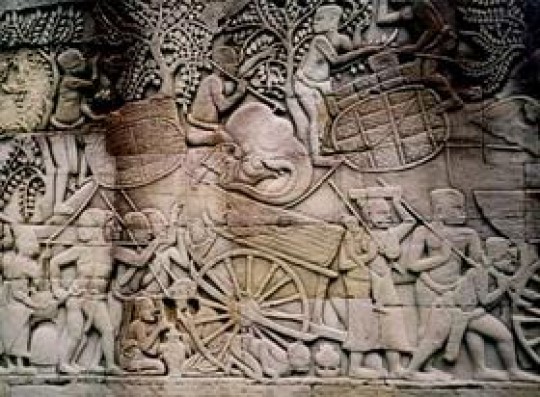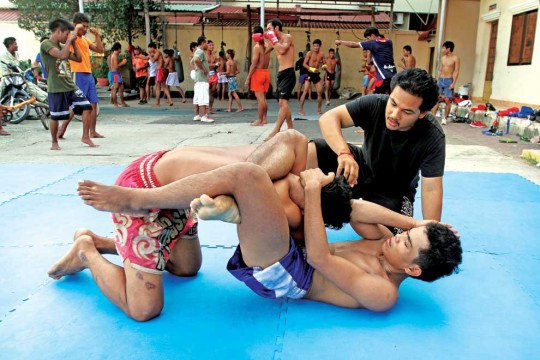Khmer Ox Cart
When contemporary innovation takes control, it is common for old-school items to vanish gradually. Khmer Ox-carts, however, is more than simply old artifacts; they were the 'Mercedes-Benz' of Cambodia’s bygone civilizations. As a result, Cambodians should preserve such a deep-rooted tool for younger people who wish to appreciate it or for those who still use it.

What is the Khmer Ox Cart?
For centuries, the Khmer ox cart has served as a significant means of travel in Cambodia. Previously known as the dominant gear of transportation in the Kingdom, they are now an uncommon sight as modern automobiles become the status quo. Back in the day, people utilized this transportation vehicle to move goods and foods across the villages inside the Kingdom. During invasions, however, ox carts were used by the army to deliver weapons and assist the battle. The oxcart is approximately 1.7 meters wide, 4 meters long, 1.2 meters high, and with 16-spoked wooden wheels.
Khmer Ox Cart Background
The ox-cart was first documented in India during the 1700s BC, in various reports such as the Book of Ideology, Religion, and technical laws such as the War Rule. There were two kinds of chariots in India at the time: ox carts for transportation and horse-drawn carriages for warfare.
Since 125 AD, both chariots have been engraved in the stone of the temples. Although the shape of the Indian chariot has altered over time, it still functions with the two wheels as the ancients. Since the beginning of the first century AD, the Khmer people in the Phnom Kingdom had adopted this vehicle from the Indians due to the impact of Indian culture. That is why the usage of ox-carts or buffaloes, which goes back to the first century AD, is still seen today.
The Khmer ox cart had an essential role in Cambodian society, not only in the social sector but also in religious beliefs, both before and during the Angkorian period. From the sculptures of Angkor Wat in the 12th century AD, we can see that the chariot that King Suryavarman II was riding on was a symbol of the sun, a hallmark of his monarchy.
Horse chariots, on the other hand, are popular in chariot procession performances, such as in the narrative of “Reamker Moha Phearat” or Buddhist tradition. In the realm of ancient sculpture, the ox-cart and horse-drawn carriage were popular among the Khmer people during the reign of Jayavarman VII.
Our archeological study reveals that chariots or chariots are sacred weapons of Narayan in Khmer Brahmanical culture and symbols of remarkable periods such as the months and seasons of the year. Thus, the Khmer people have recognized the ox cart and its sign from the pre-Angkorian period, particularly during the Nokor Phnom cultural period, as evidenced by the relics of the cart's wheel in Kampuchea Krom and other discovered artifacts.
However, several ox cart fragments were discovered in the Kampuchea Krom land. Another incredible fact is that horses have been occupied before the “Nokor Phnom”, as evidenced by the ring carvings at “Preah Har” station in Prey Veng province.
Another point that needs to be examined further is the difference between the Khmer ox cart and the Indian ox cart. There is still some uncertainty around this subject that prevents us from accurately interpreting it. However, we believe that the Khmer people of the Funan period were more influenced by China in the creation of horse chariots over the ox carts Indians.
What Do Historians Say About The Khmer Ox Cart?
The ox cart shines among the population to remind the future generation of Khmer culture from one generation to another. There are several forms of Khmer ox-carts, including "Rotes Krabey," known as buffalo cart, and "Rotes Trodous," which includes a two-level passenger seat.
In the past, high-privileged people typically traveled in "Rotes Sarley," a roofless two-wheel ox cart noted for its speed and built from premium wood spotted in tropical areas.
According to Sambo Manara, a Cambodian historian, ox carts were utilized as a prestige icon in earlier civilizations. "Everyone would have spotted how affluent or exalted the people’s status was in the King's court when they went out on their ox carts," Manara explains. "Acquiring a “Rotes Sarley” was like owning a brand new Mercedes-Benz."
Ox carts have been utilized in Cambodia since the era of King Jayavarman VII (1181–1218), according to Michel Tranet, a well-known Cambodian archaeologist. "The most widely accepted view is that Indians inspired ox carts, the first foreigners to come in what became Cambodia," Tranet continued. But regardless of all that, ox-carts became extra indispensable when the Khmer Rouge took control in 1975, as vehicles and all contemporary motorized automobiles were considered by the government as symbols of the "greedy capitalists and imperialists."
Ox Cart's Role: From "Khmer Traditional Transportation" To "Khmer-Theme Decoration"
The truth is Khmer ox carts could go extinct due to various circumstances, including people's preference for high-tech automobiles over our ancestors' traditional carts from ancient times.
Aside from the new construction of this traditional ox cart, farmers in Trapeang Anchanh village, Svay Chrum commune, Rolea Bier District have collected ancient ox carts from rural regions to repair, polish, and sell to consumers. When sold out, each unit costs between $300 and $450, depending on the quality of wood or rosewood used, and the majority of them are gone before the Khmer New Year.
The majority of customers are city residents who want to beautify their community as part of their contribution to conserving national cultural heritage for future generations to know.
Some people in the city purchase Khmer ox carts to show in the village for their children to learn about because most people no longer use ox carts. Even modern farmers today would prefer using a bulldozer or other machines for their farming productions.
In a similar way, ox carts nowadays are utilized to carry visitors, who can ride for one or two hours to experience this century-old traditional mode of transportation and see the wonderful temples and natural sightseeing in the vicinity. Therefore, if you happen to visit Cambodia one day, you should never miss this eco-friendly transportation method.
Summary
You can find some stone carvings of ox carts on the wall of many temples in Siem Reap province. From this, we can see that the ox cart was used since the Angkor era. Ox carts were used for the army purpose to transport weapons and fight during wars. While people used ox carts to transport products and foods to different places around the village within the Kingdom. The Oxcart is made of wood with 4 meters long and 1.73 meters wide and is set on 16-spoked wooden wheels 1.24 meters high. That is why Oxcart can be used on the muddy road.
Nowadays, since technology has been remarkably improving, ox carts are replaced by many kinds of transportation means such as planes, cars, trucks, etc. However, oxcart is now used only in some parts of the remote areas in the country and for tourism purposes. For instance, in Siem Reap province, ox carts are used to transport tourists which they can spend one or two hours riding on to experience this century-old traditional way of transportation and discover the magnificent temples around the area. From generation to generation, the ox cart is still here shining to the population to just remind the next generation about the Khmer culture. Visit Cambodia then you can try this Eco-friendly transport.







